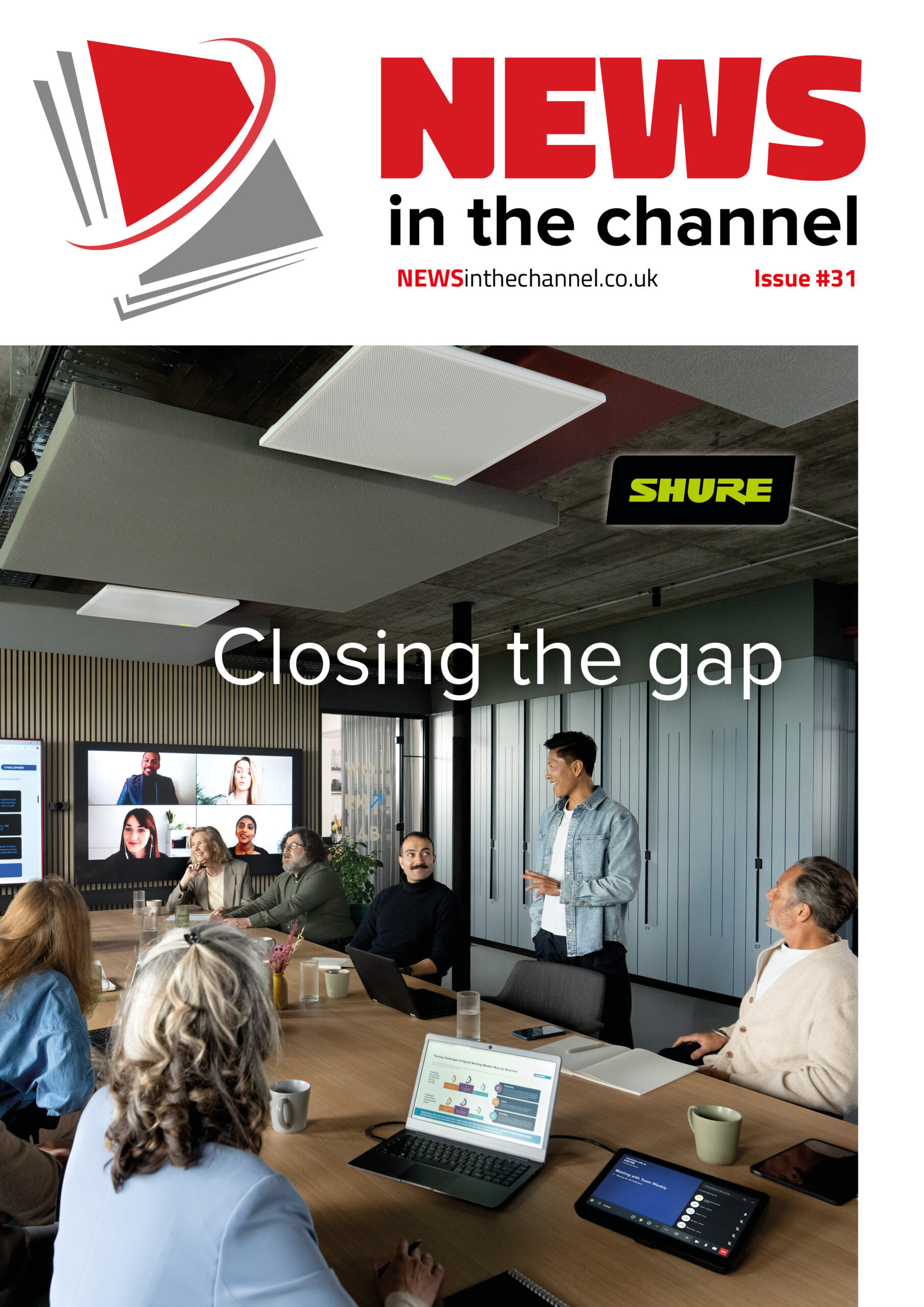Making a first impression in business is crucial, and digital walls in reception areas are becoming increasingly important – not just for creating a feature but also for giving guests, customers etc important information. In addition, they are being used more now in the office as a collaborative tool as businesses seek creative ways to tempt employees back to the office. Where will the sector go next?
In times gone by the term digital signage would have evoked eye-wateringly bright advertising displays as you walk outside Piccadilly Circus, or scoreboards that show just how bad your team are playing.
Maybe the latter just applies to me, but the Professional AV sector now has a new focus inside the office doors. Wayfinding and collaboration have become compelling use cases for AV solutions, including digital walls.
In fact, according John Perry, displays business manager at Exertis UK, the DvLED (Direct view LED) market in the UK alone is expected to grow 123% by 2025, and Western Europe revenues on DvD are expected to rise from around £350m in 2022, to £560m by 2025; a growth rate that can be somewhat attributed to the Coronavirus pandemic.
“The importance of being able to visualise information has always been there, but after the impact of covid, this has accelerated the wider need,” said Perry. “Large digital canvasses are becoming more relevant as DvLED becomes more affordable.
“As a result, businesses can utilise the WOW factor of digital wall, and tick a sustainability box with reduced servicing and maintenance outlays, when they replace damaged/faulty equipment.
“Coupling a digital wall with applications such as Microsoft front row provides the user with new options to use digital technology in their day to day environments, and opens up a world of opportunities to collaborate and share information in new ways.”
Collaboration Spaces
As Perry points out, the hybrid working model that many businesses have adopted has made the office experience very important. One part of that is ensuring that time in the office is well used to collaborate and work together in person, rather than speaking on a video call.
As a result, Taj Ghere, managing director at AV systems integrator, Kinly, says “employers need to invest in building collaborative spaces that work effectively and efficiently to suit, and empower increasingly hybrid teams.
“This is not limited to video conferencing software, which we’ve all become adept to, but highly resourced collaboration spaces, including digital signage, giving a seamless communication experience.
“In the enterprise space, a well-planned and implemented digital signage solution should provide the tools for keeping employees informed, engaged and safe. It can help keep employees and managers connected and contribute to a culture of trust, which has never been more important than now with hybrid working becoming the norm.”
Jamie Fernandez, DvLED business manager at Ingram Micro, also agreed, adding “as collaboration experiences become hybridised to accommodate greater numbers of people viewing content in large boardrooms, conference rooms or auditorium-type environments, requirement for bigger displays is greater than before, and with this we are beginning to see a need for wider aspect ratios to accommodate UC platforms.”
Size isn’t everything
That requirement placed on AV solutions in larger rooms may, to the layman, be solved by a larger overall solution. However Fernandez went on to say that “customers don’t just want size, they want an uninterrupted bezel-less experience where the display is built for their content, and subsequently their brand.
“If the content needs to bend round a wall, for example, then the display needs to be capable of this and in the case of DvLED this is achievable. Customers are also becoming even more conscious of the environmental impact of their displays, be that power consumption, or place of manufacture and subsequent transportation impact.”
Those priorities for customers can come in different forms. Although AV for collaboration purposes has become a focus for a lot of businesses, reception areas have also been the subject of a digital revolution.
And it’s not just receptions, as Ghere outlines, the AV applications are wide ranging. He said “we are seeing an evolution both in terms of the scope of how systems are used, and their reach. This is being driven both by innovation, particularly from platform vendors, and from a user perspective out of necessity through changing workplace policy.
“For example, at Kinly we are deploying solutions that deliver real-time stats to traders, live IPTV, visitor management, workplace resource booking, interactive content, ‘on demand’ signage in meeting spaces, and comms channels to remote and ‘deskless’ workers via Microsoft Teams and Webex Teams, all from a single digital signage CMS platform.”
Switched on
These solutions are clearly appealing to all manner of businesses, and they are appealing to consumers too. For resellers, Holger Graeff, general manager at Vivitek & Delta Display Solutions EMEA said that ProAV has the potential to open up new revenue streams on top of the original AV solutions.
“Customers are receptive to video walls because they are a great way to capture attention and share information, from meeting spaces, to retail environments, to control centres. Video walls that are scalable and reliable also address the need for large format information sharing.
“By offering video walls, resellers can open up new application areas to their customer, while sharpening their profile as a system and solution sales expert, given that controller, software and source management requirements also need to be considered.”
According to Philip Bacon, founder and chief strategist of Bacon Marketing, and Ghere, on top of the engaging qualities AV solutions bring, businesses are exploring ways to make video walls and screens an interaction point for people.
“Incorporating LED screen installations for high traffic areas is a great way to engage with a workforce through digital signage, “ said Ghere. “Increasingly, there are great examples of LED as art installations, which are proven to have a positive impact on employee wellbeing and can give a sense of connection with the values of the business and support a sense of community.”
“Customers’ wants and needs from digital signage are changing, and they now expect more than just static images and text,” said Bacon. “As digital walls become increasingly common in public spaces and corporate environments, consumers want dynamic and engaging content that is tailored to their interests and preferences, and that can be accessed on a range of devices.
“They also want the ability to interact with the content, whether that is through touch screens, voice commands, or other means. For example, Meta’s ‘Wish for the Extraordinary’ campaign in 2022 saw them light up Piccadilly Circus with a giant 3D astronaut to promote their new virtual reality product Quest 2.”
Looking into the Future
Such 3D displays offer a view into the way businesses will take advantage of ProAV solutions in the future, as Bacon went on to outline.
“3D displays resonate with bystanders, who pause their day to watch an ad, entranced by the bold and bright visuals and impressive effects that made it feel like they could reach out and touch the advert.
“The technology behind digital walls is evolving rapidly, with new features and capabilities being developed all the time. I think we are likely to see the integration of AI and machine learning in digital walls, helping to really finetune a business’s ability to interact on a personal level with its employees and customers.
“Using gesture or emotion recognition and haptic feedback for example, businesses can create a personalised experience, such as ads or information boards that change depending on the mood of the user.”
In the meantime, Fernandez, Graeff, and Ghere were in agreement for Perry that quality of display will continue to improve and increase in value too. “Because of recent advances in DvLED technology, customers considering an indoor video wall installation now have options beyond the traditional LCD solutions,” said Perry.
“The decision between LCD or DvLED depends on a wide range of factors; by matching client needs against the benefits of the technologies available, a cost-effective, long-term signage solution can be achieved.
“Technically smaller pixel pitches allow for larger and more affordable canvases. On top of this, new applications, mixed, augmented reality, virtual reality, and virtual production,are opening up new ways to collaborate, inspire, and deliver business needs.”











